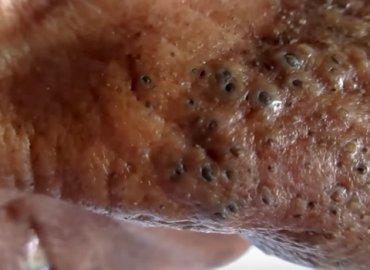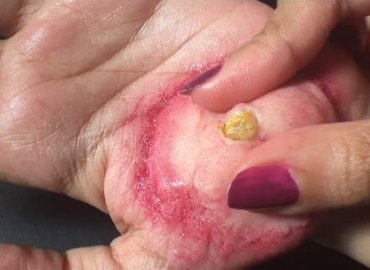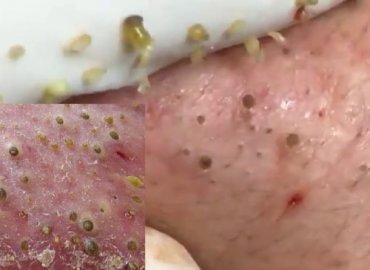Distinguish between a sebaceous cyst and epidermoid cyst. An epidermoid cyst is more common than a sebaceous cyst. Each will have slightly different symptoms and will be treated just a little differently. Therefore, it is important that the cyst you have on your skin is diagnosed appropriately for effective treatment.
Both types of cysts are flesh-colored or white-yellow and have a smooth surface.
Epidermoid cysts are more common. These are slow growing and often painless. They don’t usually require treatment, unless they are causing pain or become infected.
Pilar cysts are composed primarily of keratin (the protein that makes up hair and nails) and form from the outer hair root sheath, typically on the head. A pilar cyst is often thought to be another term for a sebaceous cysts, but they are in fact different.
Sebaceous cysts are commonly found in the hair follicles on the head. They form inside the glands that secrete sebum, an oily substance that coats the hair. When these normal secretions are trapped, they develop into a pouch containing a cheese-like substance. They are commonly found in areas near the neck, upper back, and on the scalp. Sebaceous cysts are often confused with pilar or epidermoid cysts.
Distinguish between cysts in the breast and tumors. Cysts can be in one or both breasts. Without a mammogram or needle biopsy it is almost impossible to distinguish between the two different types of lumps in the breast. Symptoms of a breast cyst will include:
- Smooth, easily movable lump with distinct edges
- Pain or tenderness over the lump
- Size and tenderness will increase just before your period starts
- Size and tenderness will decrease when your period ends
Understand cystic acne. Acne is a general term that describes a variety of different types of pimples, blackheads, pustules, whiteheads and cysts. Cystic acne are nodules that are red, raised, often 2–4 mm in size and nodular and are the most severe form of acne. The infection in a cystic acne is deeper than that in other pustules or whiteheads. Cystic acne is painful.
Identify a ganglion cyst. These are the most common types of lumps found on the hand and wrist. They are not cancerous and often harmless. Filled with fluid, they can quickly appear, disappear or change in size. They do not require treatment unless they interfere with function or are unacceptable in appearance.
Determine if pain is from a pilonidal cyst. In this condition there is a cyst, abscess or dimple that forms in the crease between the buttocks that runs from the lower end of the spine to the anus. It can be caused from wearing tight clothing, excess body hair, sitting for long periods of time or obesity. Symptoms can include pus from the area, tenderness over the cyst, or the skin may be warm, tender or swollen near the tailbone. Or there may not be any symptoms beside a pit or dimple at the base of the spine.
Distinguish a Bartholin gland cyst. These glands are located on either side of the vaginal opening to lubricate the vagina. When the gland becomes obstructed, a relatively painless swelling forms called a Bartholin’s cyst. If the cyst is not infected you may not notice it. An infection can occur in a matter of days causing tenderness, fever, discomfort walking, pain with intercourse, and a tender, painful lump near the vaginal opening.
See a doctor for swelling in the testicles. All testicular swelling must be diagnosed by a physician to determine the differences between a cyst, cancerous growth, hydrocele or infection in the testicles. A testicular cysts, also called a spermatocele or epididymal cyst, is typically a painless, fluid-filled, noncancerous sac in the scrotum above the testicles. T
Consider getting a second opinion if you are not satisfied with your physician’s diagnosis and treatment. Although most epidermoid and pilar cysts do not require treatment from a physician, if you do seek medical advice and are not satisfied with the results seek a second opinion. Most sebaceous and epidermoid cysts are straightforward, but there are other conditions that may mimic these cysts.
In a case study written in the Royal College of Surgeons of England, the authors presented two cases in which melanoma and a deep oral cavity were originally mistaken for a sebaceous cyst.
There are a variety of other infectious processes that may be mistaken for a sebaceous cyst, including boils, furuncles and carbuncles.
Treating a Cyst at Home
Treat uninfected epidermoid and sebaceous cysts at home. Signs of infection include the area becoming swollen, red, tender, or red and warm. If your home treatment for these cysts is not effective or if you experience symptoms, which indicate an infection, you should seek medical care from your physician.
If the cyst causes pain or discomfort with walking or intercourse, medical care is needed to treat the cyst.
Cystic acne is an inflammatory type of acne. Inflammatory acne results from the rupturing of the skin cell wall. When the wall surrounding a pore ruptures, bacteria and sebum can funnel into the surrounding skin cells, causing infection that results in inflammation. There are four main types of inflammatory acne, and all four may be present on the skin in cases of cystic acne.
Papules
When a follicle is blocked up with sebum, dead skin cells, and bacteria, the pressure may cause the surrounding skin cell wall to break. The substances that caused the blockage then make their way into the surrounding skin, causing inflammation. Papules are observed as red or pink-colored bumps on the skin. These acne lesions don’t contain pus and will exhibit no visible fluids. They are generally not painful but may be tender to the touch. Papules tend to be less than one centimeter wide, but can vary in size.
Pustules
A pustule is similar to a papule, except for the presence of white blood cells. When the body’s immune system senses bacteria in a ruptured follicle, it sends white blood cells to the area to protect the rest of the skin. This causes pus to build up and result in what many know as a pimple or zit. Pustules are often marked by a yellow or white head at the surface of the skin.
Nodules
A nodule is a hard acne lesion that’s embedded deep within the skin. They may persist for weeks and months, and during this time, their contents may harden into deeper cysts.
Cysts
An acne cyst (sometimes referred to as “cyst acne”) contains a hollow cavity or sac area in which fluid and liquid builds up. The fluids may harden, but cysts are generally softer than nodules. Cystic acne lesions are most often felt beneath the skin before they’re seen. As acne cysts are deep within the skin, squeezing or attempting to self-extract these lesions can actually worsen the condition, slow down the healing process, and heighten the risk of permanent, deep scarring.







